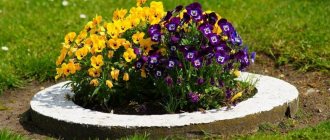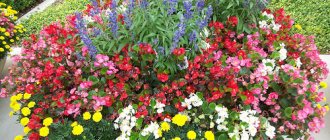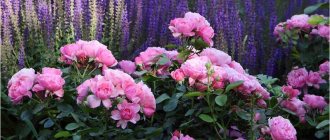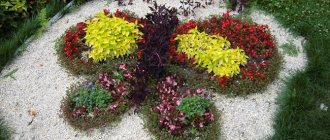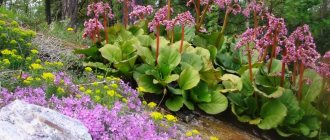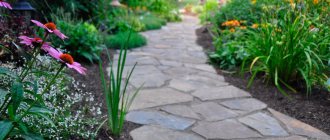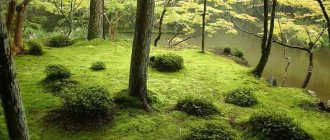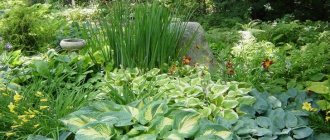Review author: Terrari School of Design
Many people try to arrange a flower bed in their garden with their own hands. This solution will allow you to beautifully and originally decorate your local area and enjoy the flowering of plants from early spring until frost. Let's look at all the secrets of designing flower beds in detail.
Selecting flower crops
To make flower beds at the dacha pleasing to the eye, it is recommended to select plants that replace each other. There are a variety of flower crops. Plants of different heights are usually selected for arranging the site.
The design of a flower bed will sparkle with new colors when choosing the following options:
- Astilbe looks attractive. It is represented by many varieties. Tall and short varieties look beautiful. Astilbe grows well in shaded areas; flowering can be admired within 7-10 weeks.
- You can't take your eyes off Helenium. The plant takes root well in the sun and shade. The crop is perennial and can withstand significant sub-zero temperatures without shelter. Helenium bushes will delight you with flowering with minimal care. They are planted in the center of the flowerbed or along the edges, depending on the design idea.
- Geranium has large inflorescences. The plant is unpretentious. Grows well. Flowers appear profusely from late spring to mid-summer.
- Catnip blooms luxuriantly. You can enjoy them in June-July. The plant is frost-resistant and does not need shelter.
- The oriental poppy looks attractive. Pleases with lush flowering with minimal care.
- The cuff is characterized by unpretentiousness. It grows to a height of 50-70 centimeters, producing lush flowers.
- Sedum multiplies quickly. Produces lush flowers with minimal care. Grows well in shaded areas.
- Rudbeckia is distinguished by its diversity. With proper care it can grow up to 2 meters in height. For this reason, it is better to plant rudbeckia in the central part of the flower beds.
There are many options for flower crops that will decorate the site in an original way. Already a photo of beautiful flower beds can attract attention. What can we say about seeing them live?
Plants used
- Hybrid daylily – Hemerocallis x hybrida “Bonanza”;
- Carpathian bellflower – Campanula carpatica “Karpatenkrone”;
- The largest cornflower – Leucdiithcinum maximum “Winner”;
- Creeping thyme – Thymus serpyllum;
- Hybrid delphinium – Delphinium x cultorum “Blue Bird”;
- Hybrid delphinium – Delphinium x cultorum “Lamartine”;
- Delphinium Ajax – Delphinium x ajacis “Pink Waltz”.
Creation of regular flower beds and flower beds
To make flower beds beautiful, they are decorated, giving the area various shapes:
- One type of plant is needed to create borders. Usually low-growing flower crops are used for arrangement. Begonia looks attractive in a flowerbed at the dacha in combination with marigolds, ageratum and others. You can also use these plants to border areas with other flower crops.
- When arranging parterres, flowers grow in the form of patterns. Typically, this involves the use of bright and lush types of flowers, various landscape sculptures or fountains.
- Various options for flower bed shapes look attractive. Square, oval, triangular, and round ones are especially often arranged. Planting flowers can be in strips located next to a fence, paths or around a gazebo.
- A complex ornament made from plant crops looks original. Arabesques are especially often arranged in this way.
Planting schemes
Planning a planting pattern isn't just necessary for landscape designers. This helps an ordinary person, far from gardening, plan the future appearance of the flower bed. It is not always possible to design a seemingly simple rectangular flowerbed on the spot.
To come up with a diagram, use paper, a ruler and colored pencils. This will make it easier for you to transfer the project to the flowerbed. To select plants according to light-loving and shade-tolerant, first of all, show on the diagram where the light and shadow are.
Next, start planning the flowerbed itself in levels, how the plants will line up in size: decreasing from the center to the edges or from one side to the other. It depends on the location of the flower bed. Remember that taller crops will grow larger once planted. Leave room for this. After this, you can already select the color scheme and plants to match it.
Sketch of landscaping of the front area. 1 - rhododendron, 2 - Virginian juniper, 3 - western thuja, 4 - prostrate juniper, 5 - common juniper, 6 - rock juniper, 7 - medium juniper, 8 - scaly juniper, 9 - heather, 10 - grass carnation, 11 - Heuchera Mikranta, 12 - gray fescue, 13 - white sedum, 14 - wormwood.
Another sketch of the front area. 1 - brachycoma, 2 - reed grass, 3 - speedwell, 4 - terry dahlia, 5 - dahlia "Jolly fellows", 6 - daylily, 7 - pampas grass, 8 - dissected rudbeckia, 9 - rejected Tagetes, 10 - evening primrose, 11 - Eremerus angustifolia, 12 - miscanthus.
Scheme of a flower bed of perennials. Flowerbed size: 1.2 by 1.5 meters. 1 - Sunflower, 2 bushes; 2 - Grenoble carnation or grayish-blue; 3 - ordinary lumbago; 4 - subulate phlox; 5 — edelweiss Soulia, 2 curtains; 6 - large-flowered coreopsis or maiden's eyes, 2 bushes; 7 - gaillardia; 8 - meadowsweet yarrow, 2 pieces; 9 — oriental poppy; 10 - paniculate phlox; 11 - chrysanthemum; 12 - larkspur or delphinium with white flowers; 13 - delphinium with blue flowers.
Scheme of a spring flower bed. 1 - purslane; 2 - daylily; 3 - adonis; 4 - primrose; 5 - periwinkle.
Another spring flower bed. 1 - daylily; 2 - sedge; 3 - lawn.
Combined rectangular flower bed. 1 - perennial blue asters, 2 - Siberian irises, 3 - blue lupine, 4 - white delphinium, 5 - lilac-violet irises, 6 - blue delphinium, 7 - white lupine, 8 - iris plicata, 9 - bright blue irises, 10 - bicolor irises, 11 - drooping lily, 12 - white iris, 13 - blue iris, 14 - Dahurian lily, 15 - hosta, 16 - dwarf iris, 17 - periwinkle.
Rules for arranging flower beds
To arrange a flower bed, compliance with various rules is shown, which are as follows:
- selection of plants that replace each other, looking decorative and attractive;
- use of flower crops with the same requirements;
- planting varieties that are compatible in height so that they do not block each other;
- planting crops in groups depending on variety;
- using 10 types of flowers in one decorative flower bed.
Sedum prominent Autumn Joy
Autumn Joy is a 40-60 cm herbaceous shrub with green foliage and bright crimson flowers collected in umbellate inflorescences. Most of the year it decorates the composition with its fleshy, slightly serrated leaves.
It begins to bloom closer to the beginning of August. At first, the inflorescences have a green tint and only then become pale pink and then deep red. Every 4-5 years, the sedum should be divided and replanted, because By this time, its bush is noticeably growing at the edges, and the center is thinning out.
- Types of garden sedums - photos, names and popular varieties
47 types of sedum with photos and descriptions.
How to plant flowers
The flowerbed will look attractive in the following case:
- The center is planting perennial plants, including bulbous plants. A place with a diameter of 20-50 centimeters is shown for them, which will give them the opportunity to subsequently grow.
- At the next stage, annual crops are planted. It is also necessary to leave space between seedlings. This will give them the opportunity to grow.
If unsightly bald spots appear on the site, you should fill them by planting crops. Usually the procedure is carried out 2-3 weeks after the main work in the spring, when it becomes clear what the territory will be like.
Soil type
The location on fertile black soil is loved by mallow, bluebell and lupine. If the soil has a lot of sand, clay or sandstone, then it is better to plant valerian, flax and sage.
Yarrow, cornflower and asters grow wonderfully on marshy soils, and carnations, cosmos, phlox and gaillardia grow on excessively dry soils.
Secrets of care
To improve the appearance of a landscaped flower bed, you should regularly care for the flower crops growing here.
It is recommended to water flower crops regularly. This will extend their flowering period. To carry out the procedure, it is recommended to use water that has stood for several days. Otherwise, the seedlings may get sick and die. In hot weather, it is recommended to water the plants every day. The procedure is carried out after sunset. Otherwise, the sun will burn the tender leaves of the crops.
Regular fertilizing is recommended. This will give the plants strength to grow and bloom. The soil is fertilized for the first time during the planting process. Then you should feed the plants until flowering time. Next, fertilizers are applied regularly, alternating mineral with organic.
In order for flower crops to grow better, it is recommended to regularly loosen the soil. Care must be taken when carrying out the procedure. Otherwise, you can damage the delicate root system.
Regularly remove weeds from the area. Otherwise, it will displace cultivated plants from the territory, taking away their beneficial substances.
It is necessary to treat plants with special means to prevent the development of dangerous diseases. The procedure is performed with special preparations, diluting them in accordance with the recommendations prescribed on the packaging.
With minimal care for the cultivated plants growing here, the flower beds will delight the eye for a long time. Flowers in this case will delight you with good growth and lush flowering.
Buddleya Davida Black Knight
Photo: www.wikiwand.com
Buddleia Davida is not the most frequent visitor to garden plots in the middle zone. However, in recent years, more and more gardeners are paying attention to this particular shrub. Buddleia needs winter shelter, but even if the ground part of the plant freezes, new shoots will grow quickly enough to delight you with abundant flowering in early August.
Black Knight is a spreading shrub up to 1.5 m high and has lilac or dark purple flowers collected in long 35-40 cm paniculate inflorescences.
- 20 plants with large flowers - bright accents for your garden
A selection of the most attractive plants with large flowers. Many of them are able to take root in the climate of the middle zone.
Photos of flower beds
Long-flowering ageratum
A profitable option for landscape design with a long flowering period. To create low borders, choose low-growing varieties with a height of up to 30 cm. They grow quickly and intertwine into a continuous flower shaft. Ageratum inflorescences look like small fluffy balls collected from small baskets.
They decorate the flowerbed from June until the first frost. As the ageratum matures, it is trimmed to adjust its height and remove old faded stems. Varieties with blue flowers are most often used, but you can create a variegated mixed mix with white, pinkish and lilac shades.
Delicate daisy
Modern decorative daisies trace their history back to a simple wildflower. They have been decorating gardens and flower beds for almost 500 years. Herbaceous low plants fit ideally into border planting areas in sunny or partial shade. They are considered good companions for spring bulbs: tulips, daffodils. They easily tolerate unfavorable seasons and wintering in open ground.
Daisies bloom from May to June. By cutting off old flower stalks you can extend this period. Based on the type of flower, there are simple, pompom and double flowers. The color of the petals ranges from white to burgundy. There are also varieties with two-color, striped and speckled inflorescences.
Luxury Brunera
Most low ornamental plants develop and bloom well in conditions of good light or partial shade. Brunera is suitable for decorating a border in a shady area. This is an unpretentious perennial with neat clusters of white, blue or combined flowers, similar to forget-me-nots.
Brunera blooms for about a month from May to June, but the large silver-green foliage with dark veins or borders remains decorative until late autumn. The lush greenery of brunera pairs well with flowering plants.
For easy care, we recommend planting large-leaved varieties - they do not grow for a long time and do not require replanting.
